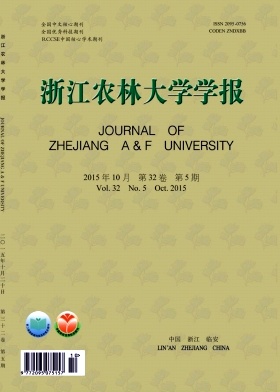| [1] |
ZHANG Niu, CUI Xiao, CHEN Chunyan, ZHANG Youfu.
Regulatory effects of exogenous silicon on morphological characteristics and physiological stress resistance of Platycladus orientalis seedlings under shading stress
. Journal of Zhejiang A&F University,
2025, 42(): 1-10.
doi: 10.11833/j.issn.2095-0756.20250246
|
| [2] |
MAO Haonan, YANG Xing, LU Kouping, WU Jiasen, WANG Hailong.
Effect of iron-modified biochars on soil nutrients and bioavailability of As and Pb
. Journal of Zhejiang A&F University,
2024, 41(6): 1222-1232.
doi: 10.11833/j.issn.2095-0756.20240171
|
| [3] |
YANG Jie.
Effect of N and Si addition on phytolith-occluded organic carbon in Phyllostachys edulis
. Journal of Zhejiang A&F University,
2024, 41(2): 369-378.
doi: 10.11833/j.issn.2095-0756.20230460
|
| [4] |
FENG Gelin, GAO Jing, YAN Shuxian, WANG Jing, LIANG Chenfei, QIN Hua, CHEN Junhui, XU Qiufang.
Characteristics and diversity of endophytic diazotrophs in three bamboo species
. Journal of Zhejiang A&F University,
2021, 38(6): 1203-1212.
doi: 10.11833/j.issn.2095-0756.20190586
|
| [5] |
WANG Xia, HU Haibo, CHENG Can, ZHANG Shuai, CHEN Jianyu, LU Honglin.
Soil PhytOC sequestration in Quercus acutissima forest in northern subtropics
. Journal of Zhejiang A&F University,
2021, 38(1): 1-9.
doi: 10.11833/j.issn.2095-0756.20200283
|
| [6] |
ZHANG Yunqing, ZHANG Zhen, SUN Kai, JIANG Peikun.
A comparative study of the PhytOC sequestration potential in the trunk of Pinus massoniana of different provenances
. Journal of Zhejiang A&F University,
2020, 37(5): 883-890.
doi: 10.11833/j.issn.2095-0756.20190583
|
| [7] |
ZHANG Yong, HU Haibo, WANG Zeng, HUANG Yujie, LÜ Aihua, ZHANG Jinchi, LIU Shenglong.
Varieties of active soil organic carbon of four forest types with varying incubation temperatures in Fengyang Mountain
. Journal of Zhejiang A&F University,
2018, 35(2): 243-251.
doi: 10.11833/j.issn.2095-0756.2018.02.007
|
| [8] |
ZHAO Lihua, HUANG Chengpeng, WANG Yueyue, HUANG Zhangting.
Stability of Phyllostachys edulis phytolith by scanning electron microscopy
. Journal of Zhejiang A&F University,
2018, 35(6): 1177-1181.
doi: 10.11833/j.issn.2095-0756.2018.06.023
|
| [9] |
HE Shanqiong, MENG Cifu, HUANG Zhangting, JIANG Peikun, WU Qifeng, SHEN Jing.
Research progress and forecast of phytolith-occluded organic carbon stability in soil
. Journal of Zhejiang A&F University,
2016, 33(3): 506-515.
doi: 10.11833/j.issn.2095-0756.2016.03.020
|
| [10] |
YANG Jie, XIANG Tingting, JIANG Peikun, WU Jiasen, KE Hejia.
Phytolith-occluded organic carbon accumulation and distribution in a Dendrocalamopsis oldhami bamboo stand ecosystem
. Journal of Zhejiang A&F University,
2016, 33(2): 225-231.
doi: 10.11833/j.issn.2095-0756.2016.02.006
|
| [11] |
LIU Yufang, CHEN Shuanglin, LI Yingchun, GUO Ziwu, YANG Qingping.
Environmental stress on physiological plasticity of bamboo: a review
. Journal of Zhejiang A&F University,
2014, 31(3): 473-480.
doi: 10.11833/j.issn.2095-0756.2014.03.022
|
| [12] |
LI Beilei, SONG Zhaoliang, JIANG Peikun, ZHOU Guomo, LI Zimin.
Phytolith distribution and carbon sequestration in China with Phyllostachys edulis
. Journal of Zhejiang A&F University,
2014, 31(4): 547-553.
doi: 10.11833/j.issn.2095-0756.2014.04.009
|
| [13] |
WEI Shujing, SUN Long, WEI Shuwei, HU Haiqing.
Coarse woody debris in forest ecosystems: a review
. Journal of Zhejiang A&F University,
2013, 30(4): 585-598.
doi: 10.11833/j.issn.2095-0756.2013.04.019
|
| [14] |
PAN Yue, RONG Jieqing, SHENG Weixing, GUI Renyi.
Silicon and drought resistance of Phyllostachys violascens
. Journal of Zhejiang A&F University,
2013, 30(6): 852-857.
doi: 10.11833/j.issn.2095-0756.2013.06.008
|
| [15] |
LI Zimin, SONG Zhaoliang, LI Beilei, CAI Yanbin.
Phytolith production in wetland plants of the Hangzhou Xixi Wetlands ecosystem
. Journal of Zhejiang A&F University,
2013, 30(4): 470-476.
doi: 10.11833/j.issn.2095-0756.2013.04.002
|
| [16] |
MENG Cifu, JIANG Peikun, XU Qiufang, ZHOU Guomo, SONG Zhaoliang, HUANG Zhangting.
PhytOC in plant ecological system and its important roles in the global soil carbon sink
. Journal of Zhejiang A&F University,
2013, 30(6): 921-929.
doi: 10.11833/j.issn.2095-0756.2013.06.018
|
| [17] |
FAN Ye-qing, ZHOU Guo-mo, SHI Yong-jun, DONG De-jin, ZHOU Yu-feng.
Relationship of slope aspect and position on biomass and carbon storage in a Phyllostachys edulis stand
. Journal of Zhejiang A&F University,
2012, 29(3): 321-327.
doi: 10.11833/j.issn.2095-0756.2012.03.001
|
| [18] |
QIAN Yi-fan, Yilita, DOU Pei-min, ZHU Guo-liang, YING Bao-gen, YU Shu-quan.
Biomass and carbon fixation with oxygen release benefits in an ecological service forest of Jinyun County,China
. Journal of Zhejiang A&F University,
2012, 29(2): 257-264.
doi: 10.11833/j.issn.2095-0756.2012.02.016
|
| [19] |
WANG Dong, GONG Wei, HU Ting-xing, CHEN Hong-zhi, WANG Jing-yan, LI Xiao-ping.
Growth and biomass carbon sequestration of young Eucalyptus grandis with fertilization
. Journal of Zhejiang A&F University,
2011, 28(2): 207-213.
doi: 10.11833/j.issn.2095-0756.2011.02.006
|
| [20] |
YAN En-rong, WANG Liang-yan, YANG Wen-zhong, ZHOU Wu.
Ecological benefit from nutrient cycling in the Tiantong regional forests of Zhejiang Province
. Journal of Zhejiang A&F University,
2010, 27(4): 585-590.
doi: 10.11833/j.issn.2095-0756.2010.04.018
|









 DownLoad:
DownLoad: